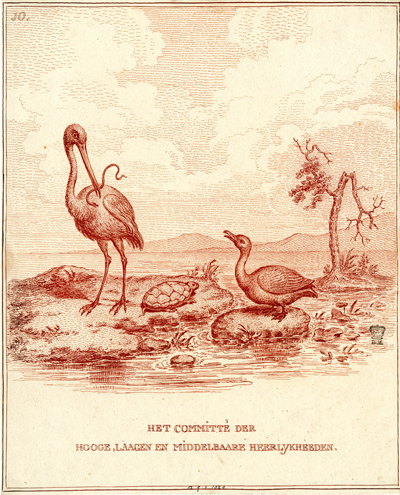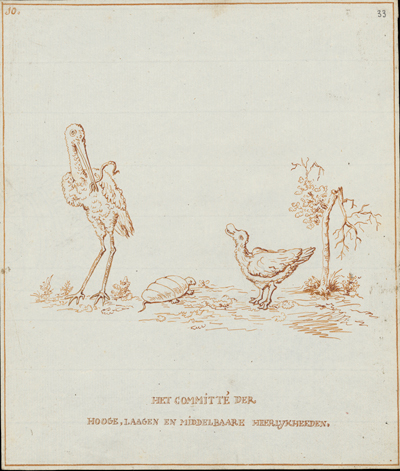Het Committé der Hooge, Laagen en Middle-Baare Heerlykheeden
This is the tenth plate of a twenty plate series, Hollandia Regenerata, etched by Gillray based on drawings by the Swiss soldier, painter, and caricaturist, David Hess. For more about David Hess, and the political and artistic context of the series satirizing the newly-created and French-supported Batavian Republic, see my Introduction.
The title can be translated as "The Committee of High, Low, and Middle Class." According to Joost Rosendaal whose "Nawoord" to his facsimile edition of Hollandia Regenerata is essential reading for anyone interested in the series, this committee dealt with matters concerning awards and privileges.
The print is one of several of Hess's that seem closest to the emblem tradition with its somewhat obscure symbols and minimal dramatic action. Here we see a set of three animals: a stork, a turtle, and a duck, and a sickly-looking tree whose top is falling off. There is no dramatic reason for their close proximity, and no interaction among them unless we suppose that the duck is looking enviously at the worm in the stork's mouth. But the position and size of the animals support their identification as somewhat unikely symbols of three classes: high, low, and middle.

Het Committé der Hooge,
Laagen en Middle-Baare Heerlykheeden
[1796?]
© Trustees of the British Museum
As with all the plates in the series, the corresponding page to the image contains one or more appropriately ironic Biblical quotations in Dutch and English and a satiric "Explanation" in French. The Biblical quotation would seem to predict an imminent levelling of the hierarchy shown in the image:
jeremiah, xiii. 18. "Your principalities shall come down, even the crown of your glory."
But if I understand the French correctly, the "Explanation." begins by suggesting that (ironically) the age-old seignoral rights have never been better maintained and administered. Here is the French:
Jamais les Droits Seigneurieaux n'ont mieux êté administré que depuis que la bassecour s'en mêle.
Pourquoi ce jeune arbrisseau meurt-il? pourquoi ses branches se dessechent-elles ?—On a coupé ses racines; il aurait pu devenir trop haut. Il faut de l'égalité dans les républiques.
And here is my free English translation.
Never have the Lord's Rights been better administered since the barnyard became involved. Why does this young shrub die? why are his branches drying up? Its roots have been cut off; it would have become too high. We need equality in the republics.
Rosendaal argues that Hess deplores the levelling proposed by the more radical Batavians, and that the image demonstrates the natural and inevitable inequality in the animal kingdom and thus the impossibility of levelling.
But if we remind ourselves the title of the print suggests that it represents the committee itself, we may be looking at a committee that pretends to desire equality but which actually preserves an aristocratic hierarchy in which the stork still gets the worm and trees that grow too high get cut off. And in actual fact, as Simon Schama shows, when the National Assembly was finally established, it had a very conservative cast.
There were sound reasons why this should have been. Although in principle every Dutch male over twenty was eligible to vote in the primary assemblies, in practice the regulation for the assembly had erected a number of barriers against the more disagreeable consequences of political democracy.
The turtle, after all, remained a turtle.

Het Committé der Hooge, Laagen
en Middle-Baare Heerlykheeden
[1796?]
© Zentralbibliothek Zürich
Hess's drawing in this case is the least finished of the series. There is no background (indeed very little ground at all), his stork is awkwardly drawn, and his turtle looks more like an armadillo. Gillray improves on the drawing in every way. There is now a clear horizon line with clouds above and hills beyong what seems to be a lake. His stork is accurately drawn with an appropriately fat and imperious look about him. His turtle looks like a turtle and the foreground is greatly and realistically elaborated. While in most of the earlier prints, Gillray stayed scrupulously close to his source (per his job), here he seems to have taken the sketchiness and awkwardness of the drawing as an invitation to supply from his own invention what was lacking in his source.
Sources and Reading
- Commentary from the British Museum on Het Committé der Hooge, Laagen en Middle-Baare Heerlykheeden.
- "Batavian Republic," Wikipedia
- "David Hess (painter)," Wikipedia
- "David Hess," SIKART Dictionary
- David Hess, Hollandia Regenerata (1797), Nawoord by Joost Rosendahl, Uitgeverij Vantilt, 2007
- "Emblem book," Wikipedia
- Simon Schama, Patriots and Liberators: Revolution in the Netherlands 1780 - 1813, London, 1992
Comments & Corrections
NOTE: Comments and/or corrections are always appreciated. To make that easier, I have included a form below that you can use. I promise never to share any of the info provided without your express permission.